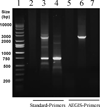Expanded genetic alphabets in the polymerase chain reaction
- PMID: 19946925
- PMCID: PMC3155763
- DOI: 10.1002/anie.200905173
Expanded genetic alphabets in the polymerase chain reaction
Abstract
Cleaning up polymerase chain reactions: Artificially expanded genetic information systems (AEGIS) add extra nucleotide "letters" to DNA alphabets; oligonucleotides containing AEGIS nucleotides do not bind to natural DNA. This "orthogonality" is exploited here by placing two AEGIS nucleotides (P and Z) in external tags for primers targeting three cancer genes in a nested PCR architecture. AEGIS tags support multiplexed PCR with fewer primer dimers and off-target amplicons than multiplexed PCR without AEGIS components.
Figures





Similar articles
-
The unusual origin of the polymerase chain reaction.Sci Am. 1990 Apr;262(4):56-61, 64-5. doi: 10.1038/scientificamerican0490-56. Sci Am. 1990. PMID: 2315679 No abstract available.
-
Recognition of an expanded genetic alphabet by type-II restriction endonucleases and their application to analyze polymerase fidelity.Nucleic Acids Res. 2011 May;39(9):3949-61. doi: 10.1093/nar/gkq1274. Epub 2011 Jan 17. Nucleic Acids Res. 2011. PMID: 21245035 Free PMC article.
-
Enzyme-assisted high throughput sequencing of an expanded genetic alphabet at single base resolution.Nat Commun. 2024 May 14;15(1):4057. doi: 10.1038/s41467-024-48408-9. Nat Commun. 2024. PMID: 38744910 Free PMC article.
-
The polymerase chain reaction.Genet Eng (N Y). 1990;12:115-37. doi: 10.1007/978-1-4613-0641-2_8. Genet Eng (N Y). 1990. PMID: 1369998 Review. No abstract available.
-
[Third-generation DNA sequencing: single molecule real-time DNA sequencing].Zhonghua Bing Li Xue Za Zhi. 2011 Oct;40(10):718-20. Zhonghua Bing Li Xue Za Zhi. 2011. PMID: 22321560 Review. Chinese. No abstract available.
Cited by
-
High-throughput multiplexed xMAP Luminex array panel for detection of twenty two medically important mosquito-borne arboviruses based on innovations in synthetic biology.J Virol Methods. 2015 Mar;214:60-74. doi: 10.1016/j.jviromet.2015.01.003. Epub 2015 Feb 11. J Virol Methods. 2015. PMID: 25680538 Free PMC article.
-
Genetic Code Engineering by Natural and Unnatural Base Pair Systems for the Site-Specific Incorporation of Non-Standard Amino Acids Into Proteins.Front Mol Biosci. 2022 May 24;9:851646. doi: 10.3389/fmolb.2022.851646. eCollection 2022. Front Mol Biosci. 2022. PMID: 35685243 Free PMC article. Review.
-
Cell-free biology: exploiting the interface between synthetic biology and synthetic chemistry.Curr Opin Biotechnol. 2012 Oct;23(5):672-8. doi: 10.1016/j.copbio.2012.02.002. Epub 2012 Apr 4. Curr Opin Biotechnol. 2012. PMID: 22483202 Free PMC article. Review.
-
FASTAptameR 2.0: A web tool for combinatorial sequence selections.Mol Ther Nucleic Acids. 2022 Aug 24;29:862-870. doi: 10.1016/j.omtn.2022.08.030. eCollection 2022 Sep 13. Mol Ther Nucleic Acids. 2022. PMID: 36159593 Free PMC article.
-
Site-specific labeling of DNA and RNA using an efficiently replicated and transcribed class of unnatural base pairs.J Am Chem Soc. 2011 Dec 14;133(49):19878-88. doi: 10.1021/ja207907d. Epub 2011 Nov 18. J Am Chem Soc. 2011. PMID: 21981600 Free PMC article.
References
-
- Krueger AT, Lu HG, Lee AHF, Kool ET. Acc. Chem. Res. 2007;40:141–150. - PMC - PubMed
- Hirao I. Curr.Opin. Chem. Biol. 2006;10:622–627. - PubMed
- Henry AA, Romesberg FE. Curr. Opin. Chem. Biol. 2003;7:727–733. - PubMed
- Kim Y, Leconte AM, Hari Y, Romesberg FE. Angew Chem Int Ed Engl. 2006;45:7809–7812. - PubMed
- Sintim HO, Kool ET. Angew Chem Int Ed Engl. 2006;45:1974–1979. - PubMed
- Leconte AM, Matsuda S, Hwang GT, Romesberg FE. Angew Chem Int Ed Engl. 2006;45:4326–4329. - PubMed
- Yu C, Henr AA, Romesberg FE, Schultz PG. Angew Chem Int Ed Engl. 2002;41:3841–3844. - PubMed
-
- Benner SA. Accounts. Chem. Res. 2004;37:784–797. - PubMed
-
- Gleaves CA, Welle J, Campbell M, Elbeik T, Ng V, Taylor PE, Kuramoto K, Aceituno S, Lewalski E, Joppa B, Sawyer L, Schaper C, McNairn D, Quinn T. J. Clin. Virol. 2002;25:205–216. - PubMed
- Elbeik T, Surtihadi J, Destree M, Gorlin J, Holodniy M, Jortani SA, Kuramoto K, Ng V, Valdes R, Valsamakis A, Terrault NA. J. Clin. Microbiol. 2004;42:563–569. - PMC - PubMed
Publication types
MeSH terms
Substances
Grants and funding
LinkOut - more resources
Full Text Sources
Other Literature Sources

